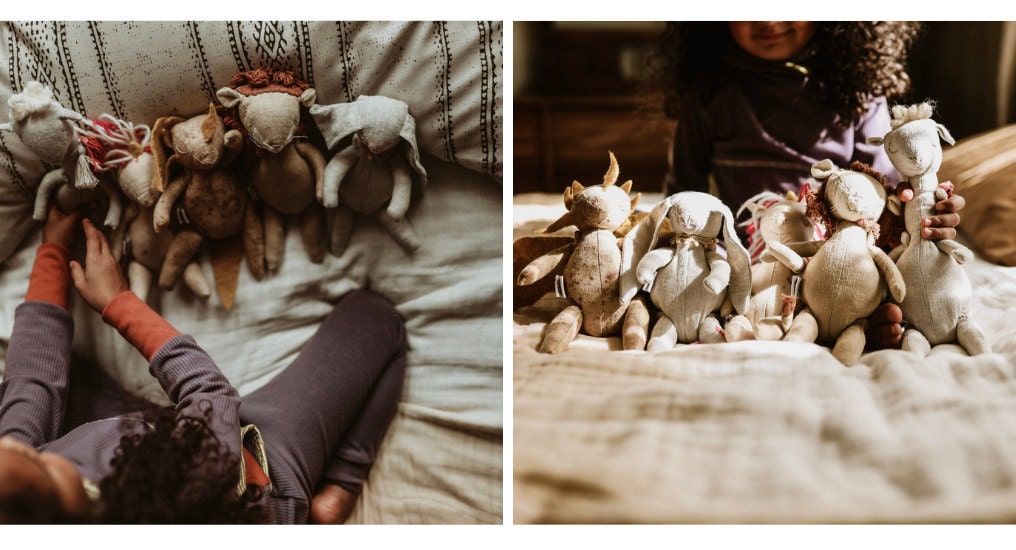I don’t know about you, but when I stop for just a moment to watch and listen to my children play, I am captured by the magic of their imaginations. Their make-believe play reminds me of my favorite parts of childhood. It is SO important to me to preserve and guard this!
These days, there are few open-ended toys. The “gadgets” that are marketed to our kids as toys talk for them, play for them, and limit their imagination. More than any generation before, our kids are growing up in an environment of streaming services, tablets, social media, parents on devices, and peers that are tech-obsessed. How do we preserve childhood play in this climate?
Why is play important?
Did you know that kids get to practice social and emotional skills through play? I mean, sure… that makes sense. But we don’t always consider how they get to “test” out scenarios and interactions with open-ended playthings.
We do it as adults too, right? We play out imaginary scenarios in our minds, practice what we might say to someone, etc. Kids do this through play! And what better way than with toys that allow the child freedom to imagine anything (open-ended toys!)
What is an open-ended-toy?
The best toys are made to foster imaginative play.
An open-ended plaything can be simply defined as a toy that has no “rules” and that is able to be played with in different ways – it should support a child’s imagination, not replace it. (Read to the end for examples!)
Play helps develop problem solving skills!
Play also cultivates thinking skills in our kids! As they problem solve within their imaginary worlds, they learn to problem solve in the real world.
A child’s imagination provides a safe zone to trial different thought processes and outcomes. And beyond the “scenarios” that the child acts out, play also encourages problem solving and critical thinking skills between children! Arguing over a toy, wrestling on the floor, expressing their feelings to one another – all of these situations help to teach the child how to interact with others in the world, how to be kind, what personal boundaries are, etc.
How can I cultivate pretend play in the home?
We can all agree that imaginative play is critical to healthy childhood development! But now the question is HOW do we foster pretend play in our homes? Here are some ideas:
- Turn off the devices
- Keep non-tech related toys – books, puzzles, open-ended-playthings – in places that are easy to see and access
- Store toys in “collections” (essentially keeping toys that work well together in the same space – dress up clothes with toy swords, train tracks with blocks, baby dolls with play food, etc.)
- Store pots, pans, mixing bowls, and spoons in unlocked low cabinets for easy access
- Leave out cardboard boxes for play before recycling them
- Donate toys that don’t get played with (less toys allows for greater use of the imagination!)
- Check out Waldorf and Montessori toy guides for more ideas!
- Be more intentional to buy toys that support open-ended play instead of following fads! (And don’t forget secondhand resources!)
Open-Ended Toy Examples
What are NOT open-ended toys? Some might surprise you!
- Video games
- Puzzles
- Board games
- Lego sets (the ones with the instructions)
- Art and craft kits
- Stacking rings
- Books
- Shape sorters, etc.
None of these are open-ended. That doesn’t mean that these are bad, it just means that they have “rules” that must be followed to play “correctly” with the toy. A good way to think about it is if the play can be “completed” (like a puzzle, game, or book) it is not open ended.
What are examples of open-ended toys?
- Boxes
- Play scarves
- Action figures
- Dolls
- Blocks
- Loose legos
- Play food
- Doctor play kits
- Miscellaneous crafting supplies
- Plush playthings, etc.
I guess you can see from that last example where my hand-made toys fall. 😉
My plush playthings are made to foster imaginative play. I’m committed to continue making toys that help our kids as they grow and develop. It is important to me to support make-believe and independent play as much as possible, and I know it’s important to you too!
The plush playthings that I offer are meant to foster open-ended play scenarios that allow children to practice their social skills in the ways mentione above! That is the beauty of a 100% natural, non-plastic, non-battery operated toy.
Which Plaything is perfect for you? Take the quiz below to find out!
Did you find this post about play helpful? You’ll want to take a look at my Open-Ended Play Holiday Gift Guide as the holidays draw close (Coming Nov 18th!) I will include a mixture of small shops and Prime items!

Well Friends,
I hope that these ideas have inspired you as you currate the playspaces within your home. If you want to find more inspo, follow me on Pinterest (I’ve been obsessed with pinning things lately!) and then join my group board Cultivating Creativity to share some of your ideas!
xo Alex
PS – I have learned so much from a Scholastic article that inspired this post. Please check it out here!


Leave a comment